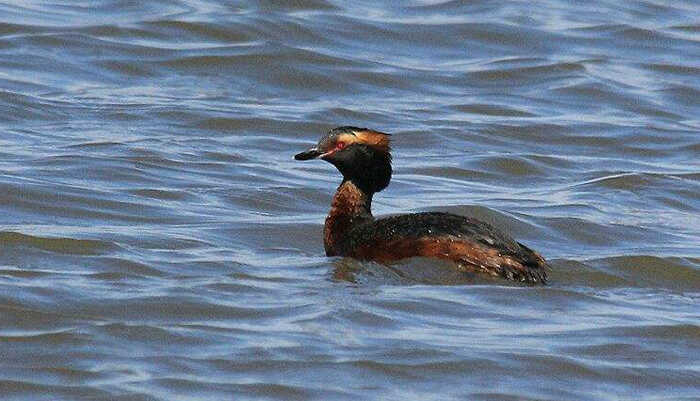Podiceps auritus
IUCN
LCBasic Information
Scientific classification
- name:Podiceps auritus
- Scientific Name:Podiceps auritus,Horned Grebe
- Outline:Waterfowl
- Family:order family genus
Vital signs
- length:36.6-390cm
- Weight:245-500g
- lifetime:No verification information
Feature
Starting from the front of the eyes to the back of the eyes, there is a cluster of golden chestnut feathers on each side extending to the back of the head, forming a double horn shape, hence the name.
Distribution and Habitat
Origin: Albania, Austria, Azerbaijan, Belarus, Belgium, Bulgaria, Canada, China, Croatia, Czech Republic, Denmark, Estonia, Faroe Islands, Finland, France, Georgia, Germany, Greece, Greenland, Hungary, Iceland, Islamic Republic of Iran, Ireland, Italy, Japan, Kazakhstan, South Korea, Democratic People's Republic of Korea, Kyrgyzstan, Latvia, Lithuania, Macedonia, Mexico, Moldova, Mongolia, Netherlands, Norway, Poland, Romania, Russian Federation, Saint Pierre and Miquelon, Slovakia, Slovenia, Spain, Sweden, Switzerland, Turkey, Turkmenistan, Ukraine, United Kingdom, United States (Georgia), Uzbekistan.
Wandering: Algeria, Armenia, Bermuda, Bosnia and Herzegovina, Cyprus, Gibraltar, Hong Kong, India, Israel, Kuwait, Lebanon, Libya, Luxembourg, Montenegro, Morocco, Pakistan, Portugal, Serbia, Svalbard and Yangmei, Syria, Tunisia.
Uncertain: Afghanistan.
China breeds in Xinjiang (west of Tianshan Mountain), found in Northeast China (Harbin, Lushun), Hebei, Henan, Shandong, w
Appearance
The horned grebe is a medium-sized waterfowl. It has a compact body and a slightly crested feather. Breeding plumage: The clear orange-yellow eye stripe and crest contrast with the black head and extend over the nape, the front neck and flanks are dark chestnut, and the upper body is mostly black. Winter plumage: The face is more white than the black-necked grebe, the bill is not upturned, and the head is slightly larger and flat. It has a short black beak that is straight and pointed, with a yellow-white tip, like a sharp chisel, suitable for pecking fish and shrimp. The wings are short and round, the tail is short, and the two legs are located at the tail. There are separate, petal-like webbed feet on the toes, and there is a comb-like protrusion on the tip of the middle toe claw, which can be used as a comb to clean the feathers. The difference from the black-necked grebe in flight is the wing coverts. The white tip of the beak is different from all other grebes but similar to the s
Details
Horned Grebe has two subspecies.

Horned Grebes move in small groups in winter. It breeds in freshwater areas throughout the northern temperate zone. Parent birds often carry their chicks on their backs when swimming. In winter, it disperses to the south of about 30° north latitude, including coastal waters, and moves in small groups. The Chinese population is very rare. It breeds in the western part of the Tianshan Mountains and hibernates in southeastern China and the lower reaches of the Yangtze River. It feeds on various fish, frogs, tadpoles, etc. It also eats aquatic insects, insect larvae, shrimps, crayfish, crustaceans, mollusks and other aquatic invertebrates, and occasionally some aquatic plants.
The call of the horned grebe: silent during the non-breeding season. The trill duet is similar to that of the small grebe, but with a heavier nasal tone; it also makes a hoarse and guttural call.
The horned grebe breeds between April and August, and usually lays eggs in June. The male and female birds have a very interesting courtship dance from acquaintance to mating. On the water surface, two grebes that meet face to face, lower their heads and spread their wings, then raise their heads and necks, flap their wings, and move forward quickly. When they are about to touch each other, they suddenly stop and move backward. It is simply a beautiful ballet. Through mutual competition and understanding of dance, if they win the love of each other, they will hold water plants and start to build a bridal chamber together.
The nest of the horned grebe is very special. It is not in a fixed place, but drifts on the water with the current. After the nest is built, 3-8 eggs are laid, and the parents take turns to incubate them. When something happens, the parent bird runs away without a trace. In fact, when it leaves, it has already covered the nest with waterweed and reeds. After 22-25 days of incubation, the chicks hatch. The chicks are precocial and jump into the water as soon as they hatch. The chicks are usually independent at 19-24 days and fly at about 41-60 days. This species is considered to reach sexual maturity at about two years old and live up to five years in the wild.
The main threats to the horned grebe are human disturbance, forestry operations around the breeding lakes (such as vegetation that causes hydrological changes, resulting in a decrease in the number of invertebrates and prey), water level fluctuations, and the cultivation of rainbow trout lakes (competing with aquatic insect species). Outbreaks of E. botulism in the Great Lakes may be an important cause of mortality. The historical range of the lakes has also contracted due to acidification and increased humus content of the lakes. The species is often caught and accidentally drowned in fishing nets and is particularly vulnerable to oil spills in the marine environment during the winter. On the Canadian grasslands, the spread of predators (common crows, raccoons, black-billed crows) threatens its population.
Listed in the IUCN Red List of Threatened Species ver 3.1: 2015-2018 - Vulnerable (VU).
Listed in China's National Key Protected Wildlife List (February 5, 2021) Level 2.
Protect wildlife and eliminate game.
Maintaining ecological balance is everyone's responsibility!








